PROS
SUV drivers can use these Goodyear tires to get a better grip on muddy or wet streets. This model comes backed with a lasting Goodyear warranty too.
BEST ALL SEASON
TIRES 2019
BOTTOM LINE
The high rating on this tire lets you know that each one you buy is suitable for your vehicle. Thanks to the wear indicator, you’ll know when to change that tire too.
PROS
Designed for use with 16-inch rims, this tire weighs less than 20 pounds. It comes with a wear indicator that lets you know when you should change and rotate your tires.
CONS
Some customers spotted signs of wear and tear on the tires after a few months of use. Others wished the tires handled better when making turns.
BOTTOM LINE
Sports car enthusiasts love this all season tire because it gives them more control on the road and when making turns. It grips to any wet surface to give you extra traction.
PROS
This tire features a hidden edge that grips and bites into loose surfaces to help you get the grip that you need. You’ll also get more control when moving around tight corners.
CONS
You may wish the warranty information was easier to follow. This tire might not work on all types of vehicles, especially those that are heavier.
BOTTOM LINE
Though this tire is softer than others, that design keeps your car on the road and reduces the vibrations that you feel inside. You can safely use this tire both on and off major roads.
PROS
The unique tread pattern on this tire makes it great for use on city streets and for off-road adventures. It provides soft and smooth traction that won’t shake your car.
CONS
Though the tire works well on snow and ice, it doesn’t perform as well on mud. You might have issues getting the balance that you need.
BOTTOM LINE
One of the best tires for any shopper, this all season tire is perfect for touring applications. It allows you to use one tire for any weather conditions you might encounter.
PROS
With wide grooves and multiple ribs, this tire will keep your car on the road and water off your vehicle. The carefully designed treads create good traction on any type of road.
CONS
You’ll need your own valve stem and rim to use this tire on your car. It may slip a little more than you would like.
BOTTOM LINE
With good traction and a solid tread, this is the best all season tire for anyone who drives a truck or SUV. It works well in both muddy and slick conditions.
PROS
SUV drivers can use these Goodyear tires to get a better grip on muddy or wet streets. This model comes backed with a lasting Goodyear warranty too.
CONS
The tire may not last as long as you would like. You should also avoid using these tires when driving on gravel roads or over rough objects.
No matter what type of vehicle you drive, you need a good set of tires. One version that you can use every day of the year is something called an all season tire. Designed for use on snowy winter days and hot summer nights, the best all-season tires will give you the traction that you need. The right all-season tires for 2018 will also help you avoid accidents when you need to come to a sudden and unexpected stop. Though you can check your manual or ask the dealership for help picking the right set, you can also use our shopping guide to find exactly what you need.
The best all-season tires for 2018 have a good tread that will grip any wet or slick road and a durable design that can stand up to both hot and cold temperatures. We’ll go over factors such as the size that you need and how much you should spend on a new set too. No matter how often you drive or the type of vehicle you drive, you really need the best tires possible. With our shopping guide, you can easily find the top all-season tires for your budget and vehicle.
Follow us on:
Get exclusive content, advice and tips from Honest Product Reviews delivered to your inbox!
Experts rank tires based on how well they perform in a series of road tests. During those road tests, they will put the tires on vehicles and send those cars out onto the road. They check how well the tires perform when used on trucks and SUVs too. The best all-season tires must grip to all types of surfaces and work in a variety of conditions. We looked at what the experts thought and the results of their road tests when creating our list of the top tires for our readers. Those road test results let us create a list of more than 20 tires that we wanted to learn even more about too.
We took all the top products and looked each one up on Amazon. Only after looking at the average rating for each set or individual tire and checking the reviews left by customers did we identify the top five options. You’ll see a little about each tire or tire set in the product matrix located right at the top of the page and via the product reviews on other parts of the page. As you read, you’ll learn when to change your tires and the benefits of all season tires also.
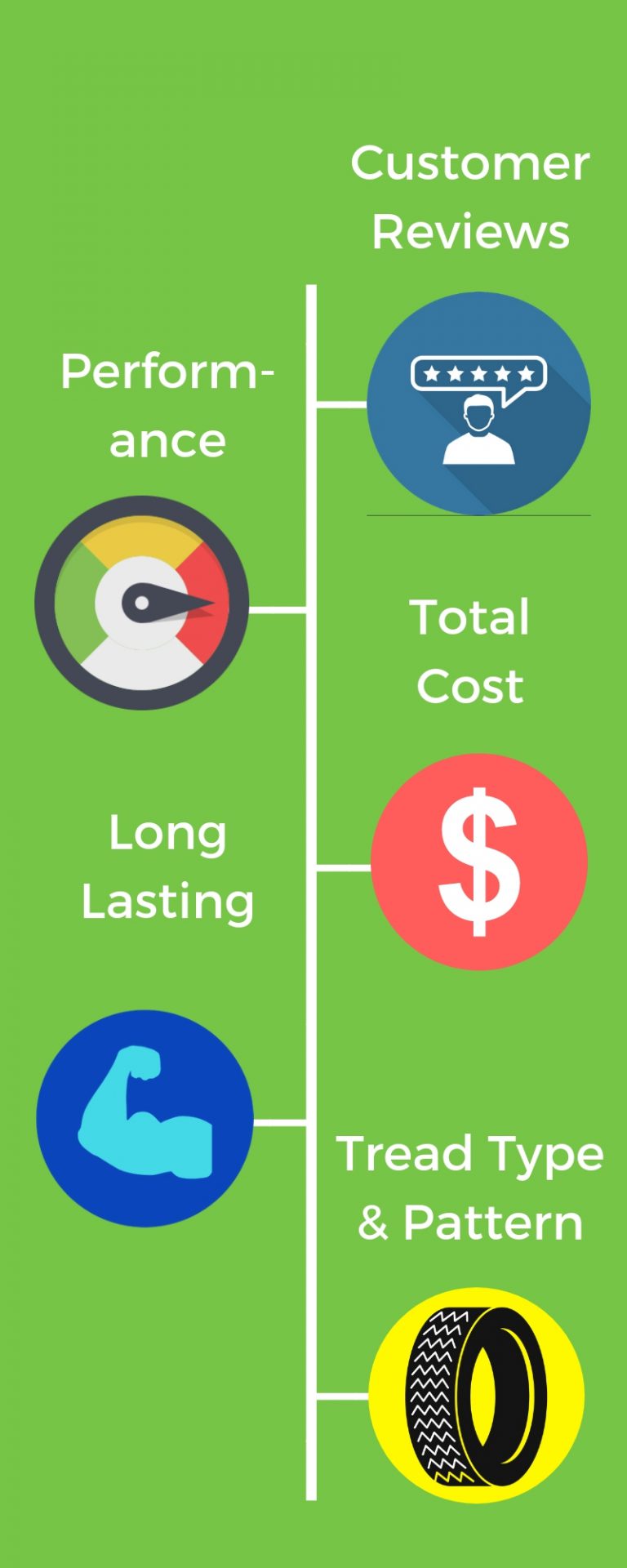
The penny test is an easy test that you can do with a simple penny to check the wear on any tire. You’ll want to turn the penny around in your hand until the head of Lincoln is on the bottom. Place the penny directly into the tread of your tire before looking at the head. If you can see any portion of his head peeking up above the top of the tread, the tire is too worn and will need replacing.
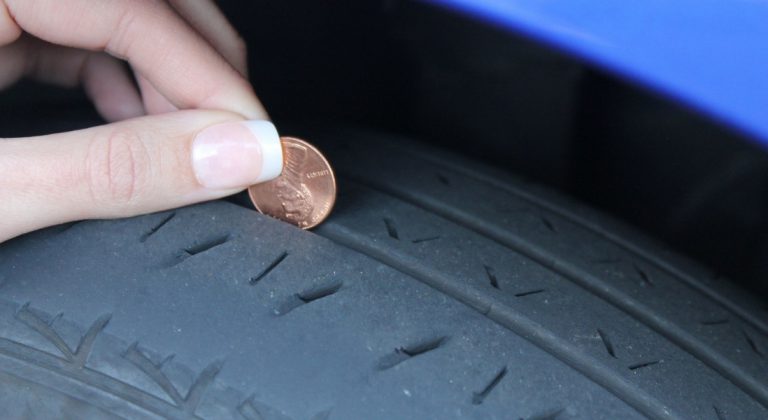
Milestar has a solid reputation for its tires, which is why this radial all season tire made our list of the best products available. It has a high uniform grade rating that lets you know that the tire has the high quality that you want and need. This also tells you that any other tires you buy of this same type will look and function exactly the same. As the tire weighs less than 20 pounds, it won’t add any extra weight to your vehicle. You’ll also find that you can easily move the tire to your garage or driveway for putting on your car.
We like that each tire has a wear indicator feature that lets you keep an eye on the rubber and see how it wears down over time. This indicator also lets you know when you should rotate your tires and when it’s time to replace it. As an all-season tire, it features a thick and durable tread that will grip to any type of road, including in snowy or icy conditions. Though this listing is for just a single tire, you can buy two or four full tires to put on your vehicle before winter hits.
There are a number of different tires that you can use on your car. When you buy a brand new model directly from the dealership though, it will likely come equipped with all-season tires though. Manufacturers like this tires because they last longer than other types do and provide a much smoother ride. If you decide to replace all four tires at the same time, you may want to look at what an all-season tire is and how it functions. These tires are essentially those that you can use at any time during the year, though you may find that they don’t perform as well in the winter as you would like.
Most models feature a tread pattern with built-in grooves or channels. Those grooves keep any moisture on the road from sticking to the rubber and allow the rubber to maintain a better grip on the road. Though some work just as well in the ice or snow, you may want to use snow tires during the winter months, especially if you drive often. Most all-season tires are adequate for use in the winter and the summer. You can look for specialty tires designed for use on mud or gravel.
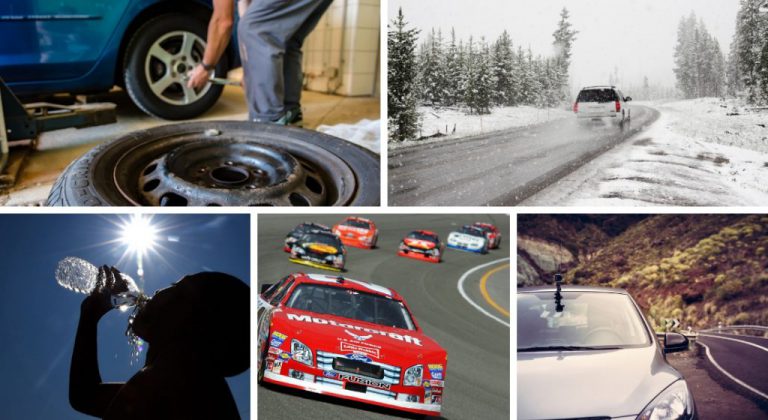
The biggest benefit of using all season tires on your vehicle is that you don’t need to switch between tires when the seasons change. Most models we looked at perform equally well in the winter as they do in the summer, though you may find that some perform better on snowy and icy roads than others. You should keep in mind that some manufacturers use the term snow mobility, which just says that the tires will remain mobile when used in the snow. If you live in an area with a high rate of snow and ice, you may want to look at models that can grip those surfaces better.
These models also come with a warranty that lasts for 50,000 miles or more. As long as you are within your mileage restriction, you can contact the manufacturer and ask that the company replace or repair your tires. Many drivers also find that these tires provide a smoother and quieter ride. You won’t hear every leaf or rock that you drive over, and you won’t notice your car shaking either. We like that all season tires come in different styles designed for sports cars and larger vehicles like trucks too.
You should check the pressure of each tire at least once every 30 days. If you don’t have a gauge of your own, most gas stations have an air machine with its own gauge that you can use for free.
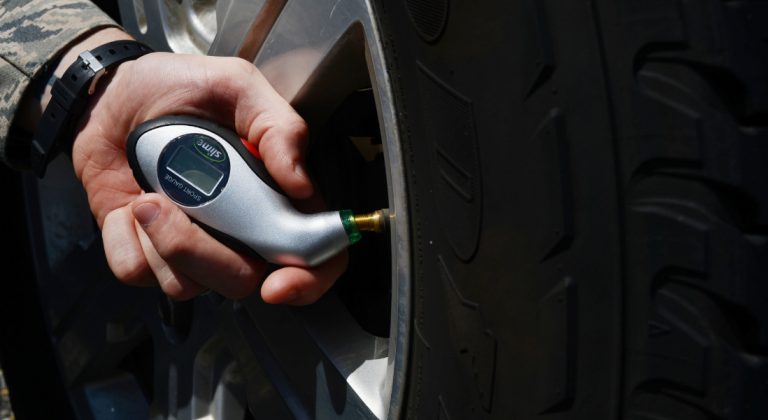
Before buying new tires for your vehicle, it’s important that you understand what all the markings on those tires mean. You can actually look at your own tires and find out what you need to look for in a new set.
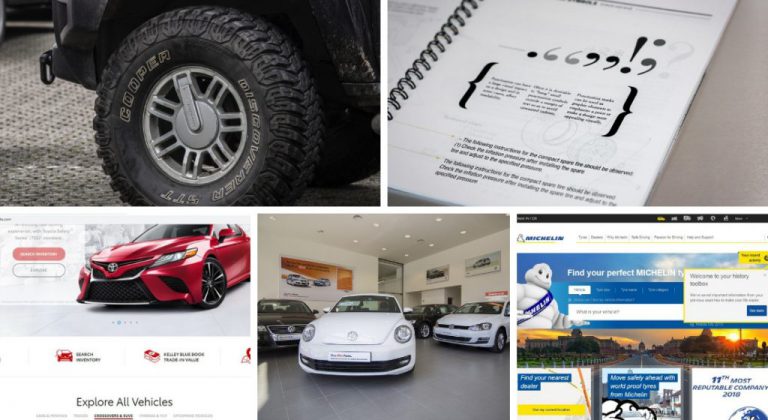
If you want tires that will work on any type of surface and are perfect for a sports car, this Michelin model is the best choice for you. Designed specifically for sports cars, this tire will not work on larger trucks or heavier vehicles. When used properly though, it provides all the traction and control that you might need. It uses a Variable Contact Patch 3.0 system designed by Michelin that allows more of the rubber to come into contact with the road. As you take turns and maneuver around obstacles, the rubber will grip to the surface to keep you from sliding.
We also like the biting edges that the manufacturer designed too. This edge, which Michelin hid inside the tire, grips to loose snow or any type of loose ground to give you more traction control. The tire also uses an exclusive surface coating that keeps the rubber tacky and sticky. Even if you need to drive on the slickest of streets, you’ll find that the tire still grips the pavement. It also has built-in grooves designed to force water away from the tires and your vehicle. Not only do those grooves keep water from splashing onto your car, but it keeps you from hydroplaning across the road.
When you look closely at all season tires, you’ll find some designed for everyday driving and some designed for better performance. It’s important that you decide between a standard model and a performance model. Standard tires will often last longer but will have a lower speed rating. Instead of holding up to speeds of 100 miles per hour or hour, standard tires may only work at a speed of around 88 mph. The warranty on standard tires typically lasts longer though because the manufacturer assumes that you won’t drive at high speeds or put those tires through the ringer.
Though you might think that performance tires are best for professional and street racers, you can actually get quite a bit of use out of a pair on a vehicle that you use to get to work or for running errands. Performance tires help you handle your car better. You might find that you have an easier time moving around corners or driving your car on a curvy road. Some also find that these tires help them brake faster and easier too. Performance tires will grip the ground beneath your car and help you come to a complete stop without your brakes or tires squealing.
If you have more money on hand and want to drive faster, consider ultra-high performance tires. These tires can run at speeds of up to 160 mph or higher.
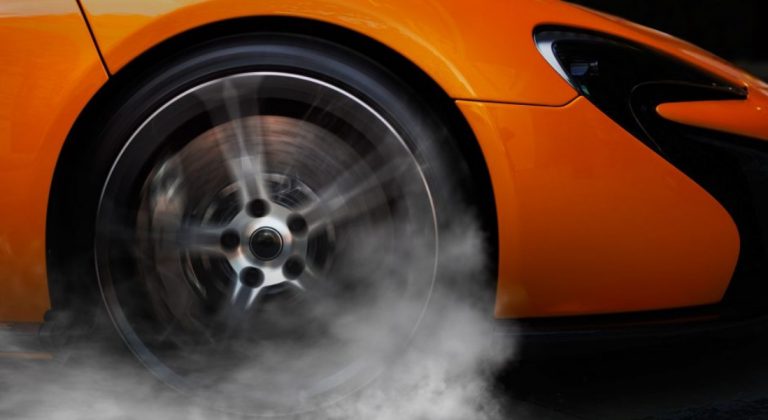
No matter what type of car part you buy, you must check the warranty before parting with your money. The first thing to consider in terms of the warranty is the number of miles that it will cover. Most all-season tires have a warranty that lasts for at least 40,000 miles. You might find some with a warranty that lasts for up to 100,000 miles too. Performance all season tires typically come with a warranty that only covers the first 20,000 to 40,000 miles that you put on those tires. If you notice that the tread wore down faster than it should or that the tires just don’t provide enough grip, you can use your warranty and get free tires or free repairs.
You should really look at what you need to do to use your warranty too. Some companies now that shipping heavy tires is expensive and a hassle, which is why they’ll let you keep those that you bought and send a new set out to you. Other companies may send you boxes and other materials and arrange for a truck to pick up those old tires. Some manufacturers will actually ask you to pay out of pocket to return your tires.

You wouldn’t expect to use the same motor in a compact car as you would in an SUV, and you shouldn’t expect to use the same tires on all types of vehicles too. When we started working on our shopping guide to the top all season tires of 2018, we knew that we wanted to include a few different options for vehicles other than cars. Our top choice and some of the other products that we included will work on both lighter and heavier cars, including sedans, sports cars, compact models and hybrids. You need to purchase tires designed specifically for the type of vehicle that you drive.
Tires made for SUVs and trucks often have a much thicker tread pattern than those found on car tires. This thicker pattern allows more of the rubber to grip the road and will help the vehicle come to a complete stop. SUVs, trucks and vans are much heavier than ordinary cars and require more stopping power. These tires are also much wider and can support the total weight of the vehicle. You’ll find some specialized models designed for vehicles from select manufacturers too. Most models for LT vehicles will work for all of those heavier vehicles though.
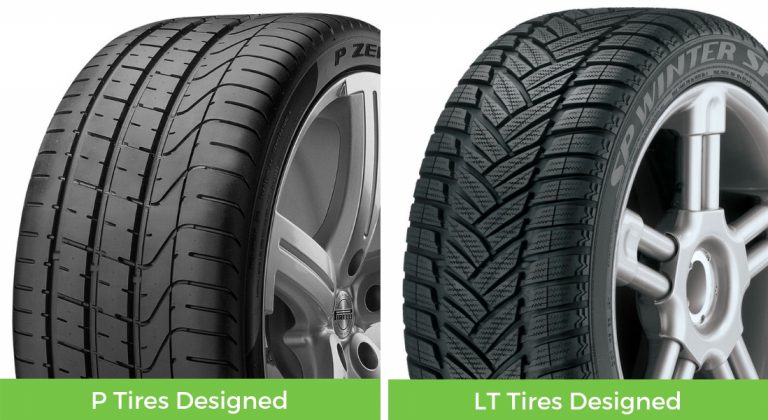
Though Cooper makes a number of different tires, the best all season model from the company is this one, which is part of its Discoverer line. The top feature we like about this tire is its soft design. Cooper added a center rib that bends as you move across different surfaces. You can actually push down on the tire and feel that center give. This helps the outer edges of the tire grip to the road to keep your car from sliding and hydroplaning. That softer design also stops your car from shaking and will reduce any vibrations you might feel inside.
Each of the five ribs that wrap around the tire work together to give you as much traction as possible. It features a tread compound made from silica and other ingredients that give you even more traction. Not only will this tire work well when driving home in the snow, but it will also provide some grip when the road ices over. Cooper also guarantees that you can use this tire on off-road trips too, though you may find that it doesn’t perform as well in muddy conditions. We also like that this tire pushes away dust and rocks from your car.
Manufacturers use different letters to tell you the maximum speed rating of a tire. If you see the letter T listed, you’ll know that the tire can handle speeds of up to 118 mph. The letter S goes along with a maximum speed rating of 112 mph. Performance tires and touring models usually have a higher rating. This is true of all season performance models too. Most of these tires use either the letter H or V. Tires with an H rating can hit speeds of up to 130 mph, while those with a V rating can work at a maximum speed of 149 mph. You may find some tires with an even higher rating.
Though most assume that they don’t need to look at the speed rating of a tire because they always follow the speed limit, that rating can give a little peace of mind. It lets you know that the tire will remain in good shape as you drive down the highway and that you won’t suffer a blowout. If the tire becomes too hot or suffers any damage, it can actually pop or break quite suddenly and cause you to veer off the road. Those with a higher speed rating can handle higher speeds and other road conditions.
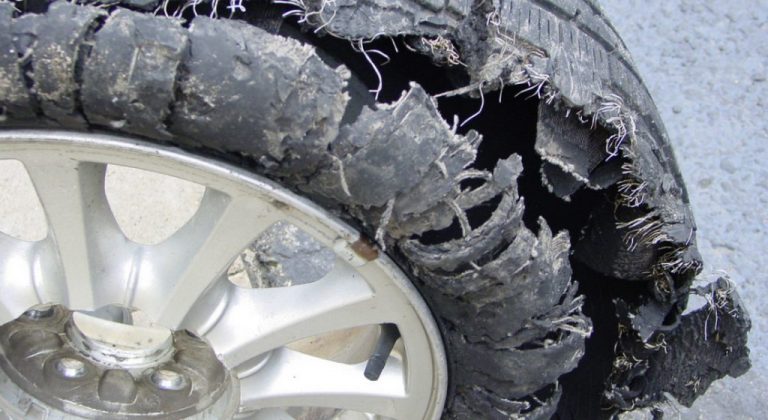
Unless you routinely haul supplies for a construction company or work part-time as a mover, you might not care much about load capacity. The manufacturers of popular all season tires will always tell you the load capacity of each individual tire. When you multiply that amount by four, you can see the total amount of weight that you can haul in your car. Most of these tires have a maximum load capacity of around 1,600 pounds. That means that a set of four can safely support up to 6,400 pounds of weight. Before you go out and load up your vehicle though, you should keep in mind that this figure includes the weight of your vehicle too. You can check your manual to find out how much your car weighs and compare that to the load capacity of the tires.
Checking the load capacity is important because this tells you the exact amount of weight that the tires can support at any one time. If you try to haul more items in your car such as bags of soil you bought for your garden or a heavy piece of furniture, you can significantly wear down the tires. That extra weight can even cause a blowout.
When looking at a tire’s load capacity, don’t forget to take into account the weight of the driver and any passengers in the vehicle.

Most all-season tires feature one of three different tread pattern types. The most common type of tread has a unidirectional pattern. The entire pattern on that tire moves in the same direction. Though this is a common type that many cars feature, it’s also one of the worst. When you buy this type of tire, you’ll need to have your tires rotated more often and you will need to keep an eye on that pattern as it wears down.
Tires that feature a symmetrical pattern will usually last longer. The grooves located on the tire features a symmetrical design that puts the exact pattern on each side. As you drive, the tires spin in the same direction and at the same time, which reduces some of the wear and tear that you might otherwise notice.
The most expensive all season tires feature asymmetrical tread patterns. As the pattern features different lines and designs working together, more of the rubber can touch and grip to the surface beneath you. These tires work well on both muddy roads and slick city streets. Most sports car owners prefer using these tires on their cars because of the traction provided. If you decide on an asymmetrical pattern, you should know that these tires can cost almost twice what the others do.
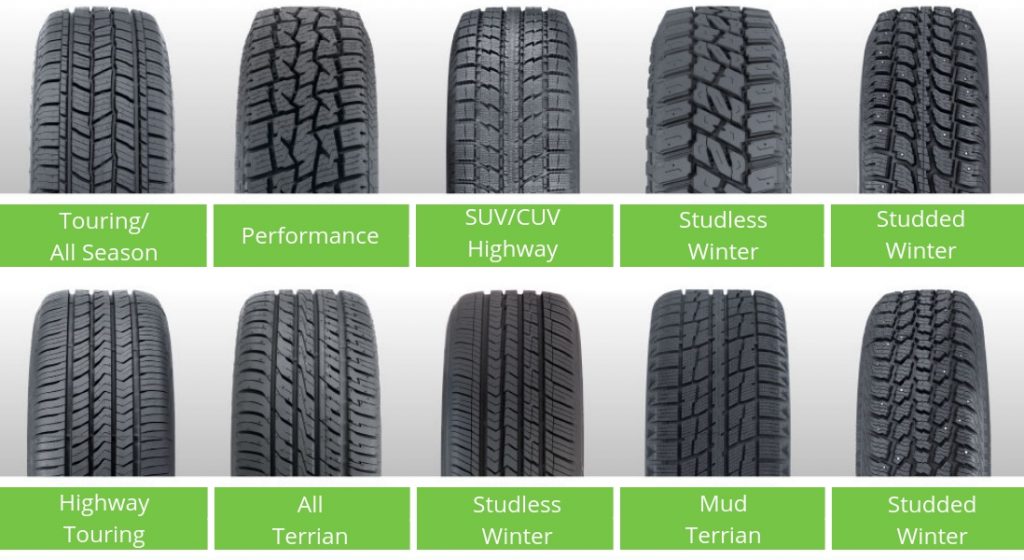
It’s almost impossible to create a list of the best tires without Goodyear appearing on that list. We think the company’s Eagle RS-A Radial Tire is the best choice for anyone who trusts the Goodyear name and any shopper who wants a good amount of traction. This is one of the only models that combines all the benefits of an all-season tire with a touring tire. Not only does it provide lots of traction, but it will last longer than other types will. As a touring tire, it actually reduces any noises or vibrations that you would otherwise feel and hear from inside your car.
Unlike other tires that have ribs evenly spaced across the surface, this tire has an asymmetrical design that features both thinner and thicker ribs. This design extends the life of the tire and lets you enjoy a much smoother ride. Whether you drive on a straight and smooth road or need to maneuver around tricky corners and tight curves, this tire will work for you. While some manufacturers make all season tires designed more for winter use, Goodyear recommends this tire for year-round use. It works equally well on both slick roads and dry surfaces.
Though we already talked about the letters on your tire and how those letters help you choose between a passenger and a light truck tire, you should also look for new tires of the right size. The best way to find the right size is with a look at the information on one of your old tires. Even if the white letters and numbers are too worn down on one tire to see, you can usually find that information on another tire. You’ll want to pay special attention to the numbers that correspond to the width and the type of tire. If you buy LT tires for a sedan, they will not fit onto the car. Those designed for passenger vehicles are much too small for use on an SUV or truck too.
If you cannot find the information you need on one of the tires, open your driver’s side door and look for a label on the inside. Many manufacturers put a label here that provides you with some basic info, including the pressure that your tires require and the size of tires that you need. You’ll also find this information inside your manual, which is usually inside your glove box.

You should never replace just one tire at a time. That single tire can actually wear down faster than it should because it must compensate for your other worn out tires.
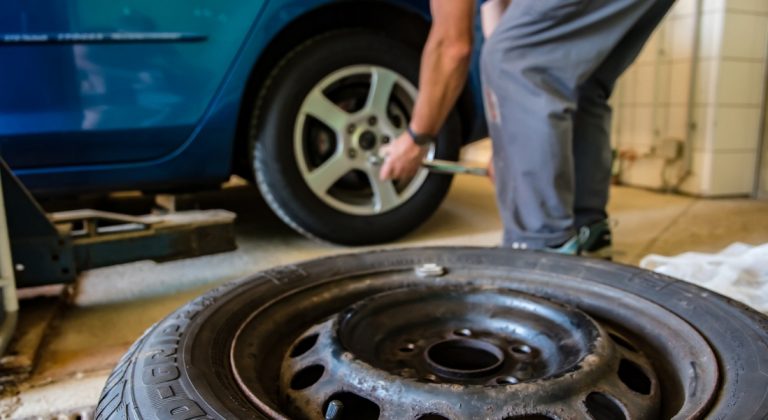
If you lose lug nuts when changing a tire, you can actually remove one from each of the other wheels and use the other three to secure the new tire in place. This gives you time to get to a shop and buy new lug nuts.
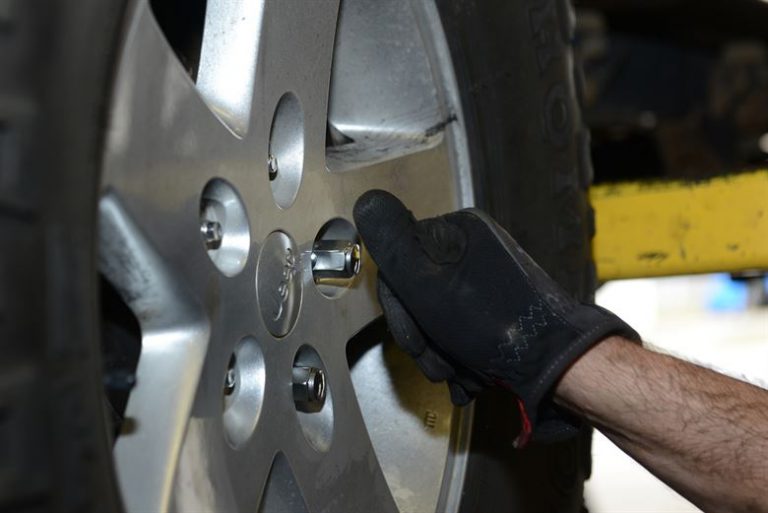
Though you might see the word Wrangler in this title and assume that these tires are only suitable for Jeep owners, Goodyear recommends this model for any type of light SUV or truck. When you buy a single tire or a whole set from Amazon, you can have the product shipped right to your nearest shop and let an expert install the tire(s) for you. This is one of the few tires we found that will work well on both muddy and slick roads. The tread does a good job of gripping the ground while pushing away the mud and snow from your vehicle.
Unlike other tires that feature a series of ribs with the tread pattern added to the top of each part, this tire features an extremely unique tread pattern. Goodyear runs that pattern back and forth across the tire rather than up and down, which may help you get the traction that you need in your driveway or on a rural road. While you’ll want to avoid gravel roads, you can drive across dirt or muddy roads with ease. Many shoppers claimed that these tires provided them with a smoother ride and that they got better control when using a set.
If you have quite a bit of grass and leaves trapped in your tire’s tread, you can use your garden hose on a high-pressure setting and force water along the tread pattern. That steady stream of water can remove much of the debris and save you some scrubbing later.
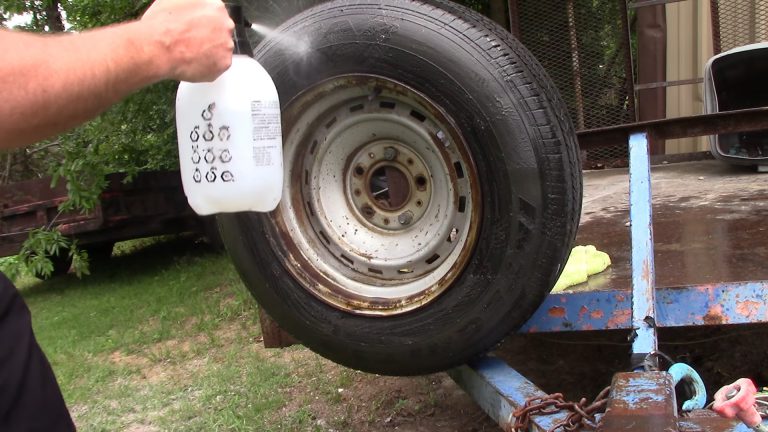
When you see your car sitting outside in the natural light, do you ever think that your tires look slightly brown? While most car tires are black with some white accents, that rubber can develop a brown appearance due to the aging process or because of damage caused by the sun. A simple application of tire gel is all you need to restore the original look of your wheels. You will clean the wheels first and then use the following steps.
You should wear gloves when applying a tire gel to keep the solution from staining your hands. We recommend washing your hands before you eat or touch anything too.
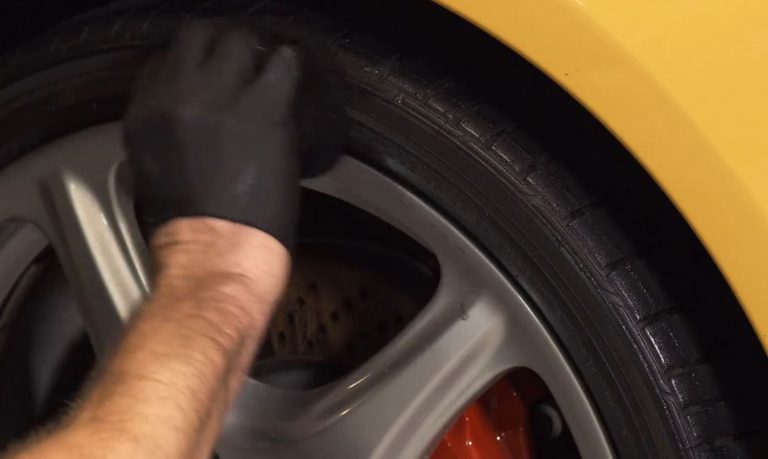
No matter how often you drive or the surfaces that you drive on every day, you should still inspect your car tires on a regular basis. This is especially true of all season tires because you might use the same set for all four seasons. The most important thing to look during the inspection is the wear pattern. This refers to the pattern of wear and tear that you see on the tread. You can actually do the penny test here if you have a hard time seeing that pattern for yourself.
During the inspection, you may want to jack up your car and spin each tire one at a time. This lets you see how smoothly the wheels turn and will give you an idea of whether you need any repair work. As the wheels spin, make sure that you look for any damage to the tires. Now is a good time to look for anything that might stick out from the surface of the rubber or any small holes that you can see with the naked eye. If you see any holes or objects that will leave behind a hole, you can take your car to a tire shop and have a repair tech patch that hole.
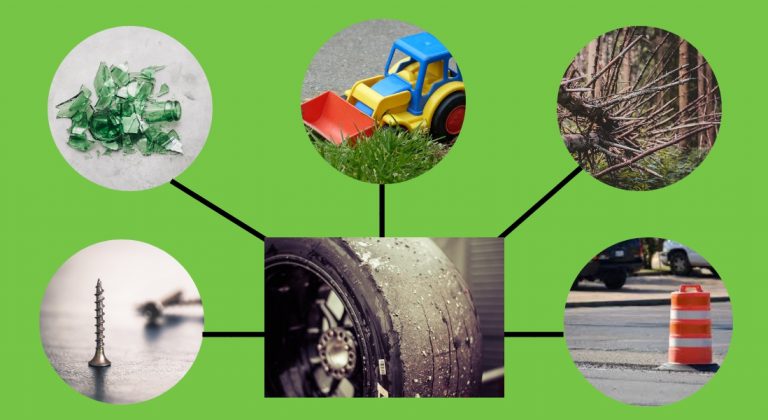
It usually takes between one and two hours for a tech to rotate and balance your tires. The balancing process takes longer than the rotating does. If you’re in a hurry, you can make an appointment for a tire rotation alone and get out of the shop in an hour or less.

When your tire blows out on a busy highway, you’ll likely feel your heart leap into your throat because you don’t know what to do. As soon as this occurs, you need to keep a grip on your steering wheel and take a deep breath. This will help you clear your head and focus on what you need to do next. You must first get off the road as soon as possible. Whether you’re on a highway or a quiet road, you’ll want to pull your car off the road and make sure that no part of the vehicle is still in the path of traffic. It’s a good idea to have flares and other supplies in an emergency kit that you keep in your trunk or back seat.
If you have roadside flares, you can put those flares around the front and back of your car to let other drivers know that you’re there. Though you may have a spare tire and jack in your car, you may need to call for help. Experts often recommend that you stay in your car until help arrives. If you stand near your car, you risk another vehicle hitting you as it passes by.

Though you might feel tempted to buy a set of used tires to save some money, you should really avoid them. Even if you have a shop right down the street from you that specializes in used tires and offers guarantees on all products sold, you should save your money and invest in a new set. The main problem with old tires is that you have no idea how much life they have left in them. A sales rep might swear that they came off a new car that a little old lady drove to the store and church each week when they actually came off a street racing car. That old set of tires may only last for a few months before you need to buy a brand new set.
Another problem with old tires is that you may not know what to look for when you do a quick inspection. You never know when those tires might have a busted inner tube or when they might have tiny glass particles stuck in the rubber that will cause the tires to pop when you hit the highway. It’s often better to buy one or new tires than to spend money on a full set of used ones.
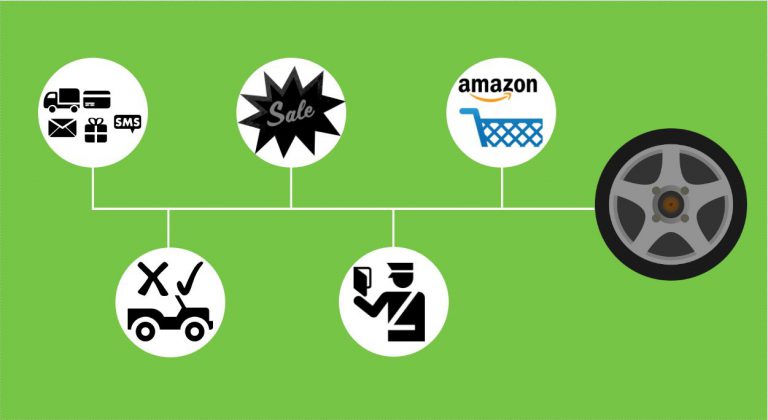
The average price that you’ll pay for a new set of tires will often depend on where you buy. Dealerships and tire shops often charge more than websites do and will charge you even more to put those tires on your car. Some of these shops offer cheap tires but charge you double what you should pay for a set. You will typically buy a single tire and multiply the cost by the number of tires that you need. Websites such as Amazon make it easy to buy a single tire, a pair or a full set of four tires.
Prices usually start at around $50 to $70 per tire. These are smaller tires designed for sports cars and vehicles that weigh less than others. The prices can reach $90 or more for a durable tire that you can use on a car or truck. If you want to buy from one specific manufacturer, you’ll likely find that some companies can and do charge more. Goodyear tires, for example, often cost more because of the company’s strong reputation. When you spend more on a single all season tire or a complete set, you’ll often get a better warranty that will last for 60,000 to 80,000 miles or more.
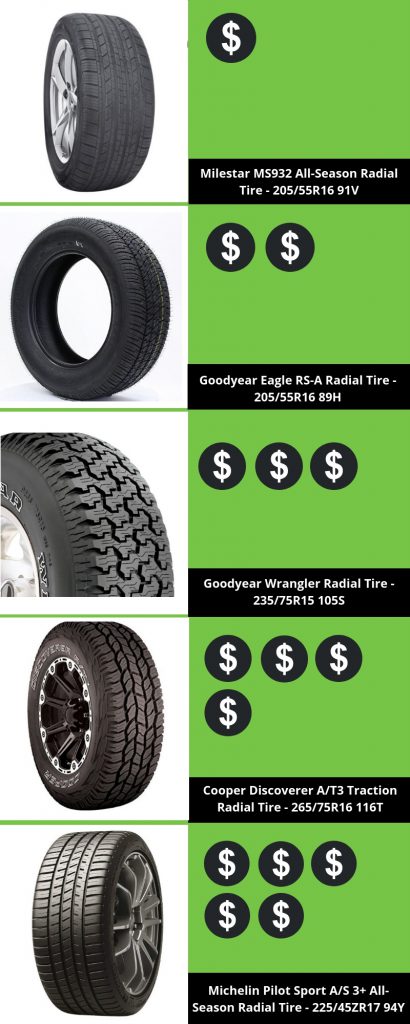
A: When you have a flat tire and take it off to put on a donut, you should get to a repair or tire shop as soon as possible. Manufacturers generally recommend that you put no more than 70 miles on one of these tires and that you drive no faster than 50 mph. Donuts are not strong enough to stand up to daily use and can pop at high speeds and cause a serious accident.
A: A mud terrain tire is a type designed specifically for off-road use. They have a much wider tread with thicker grooves that expel the mud you drive on and over. Most have reinforced areas that keep the tires from popping as the rubber touches sharp objects. All-terrain tires are fairly similar but are better suited for different conditions.
A: You should typically rotate your tires every 6,000 miles that you drive. If you drive less often or primarily on flat surfaces, your tires might last a little longer. Some experts recommend rotating your tires every 3,000 miles. Regular rotations will help the tires wear evenly and make a new set last longer.
We have access to thousands of products, and have meticulously and personally hand selected the very best for you to check out.




We are a participant in the Amazon Services LLC Associates Program, an affiliate advertising program designed to provide a means for us to earn fees by linking to Amazon.com and affiliated sites.